Related Research Articles
4349 Tibúrcio, provisional designation 1989 LX, is a dark asteroid from the central region of the asteroid belt, approximately 29 kilometers in diameter. It was discovered on 5 June 1989, by German astronomer Werner Landgraf at ESO's La Silla Observatory in northern Chile.
Arago, provisional designation 1923 OT, is a dark asteroid from the outer regions of the asteroid belt, approximately 55 kilometers in diameter. It was discovered on 5 September 1923, by Russian astronomer Sergey Belyavsky at the Simeiz Observatory on the Crimean peninsula. The asteroid was named after French mathematician François Arago.
Pawlowia, provisional designation 1923 OX, is a background asteroid from the central regions of the asteroid belt, approximately 20 kilometers in diameter. It was discovered on 5 October 1923, by Soviet astronomer Vladimir Albitsky at the Simeiz Observatory on the Crimean peninsula. The asteroid was named after Russian physiologist and Nobelist Ivan Pavlov.

1039 Sonneberga, provisional designation 1924 TL, is a dark background asteroid, approximately 34 kilometers in diameter, located in the central region of the asteroid belt. It was discovered on 24 November 1924, by German astronomer Max Wolf at Heidelberg Observatory in southwest Germany. The asteroid was named for the German city of Sonneberg, where the Sonneberg Observatory is located.

1032 Pafuri, provisional designation 1924 SA, is a dark background asteroid from the outer regions of the asteroid belt, approximately 65 kilometers in diameter. It was discovered on 30 May 1924, by English astronomer Harry Edwin Wood at the Union Observatory in Johannesburg, South Africa. The asteroid was named for the river in the Pafuri Triangle in South Africa, created by the confluence of the Limpopo and Levubu rivers. The body's spectral type and rotation period are still poorly determined.
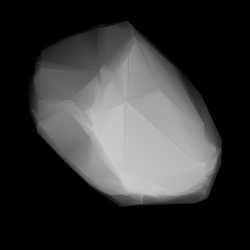
1118 Hanskya is a large background asteroid, approximately 77 kilometers in diameter, located in the outer regions of the asteroid belt. Discovered by Sergey Belyavsky and Nikolaj Ivanov in 1927, it was named after Russian astronomer Aleksey Hansky. The presumed dark C-type asteroid has a rotation period of 15.6 hours.
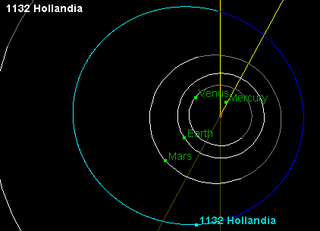
1132 Hollandia, provisional designation 1929 RB1, is a stony asteroid from the middle region of the asteroid belt, approximately 27 kilometers in diameter. It was discovered on 13 September 1929, by Dutch astronomer Hendrik van Gent at Leiden Southern Station, annex to the Johannesburg Observatory in South Africa. It was named for the region Holland in the Netherlands.
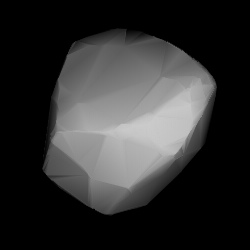
1457 Ankara, provisional designation 1937 PA, is a stony asteroid from the central region of the asteroid belt, approximately 18 kilometers in diameter. It was discovered on 3 August 1937, by German astronomer Karl Reinmuth at Heidelberg Observatory in southwest Germany, and later named for the Turkish capital city of Ankara.
1815 Beethoven, provisional designation 1932 CE1, is a carbonaceous background asteroid from the outer regions of the asteroid belt, approximately 30 kilometers (19 miles) in diameter. It was discovered on 27 January 1932, by German astronomer Karl Reinmuth at the Heidelberg Observatory. The uncommon F-type asteroid seems to have a long rotation period of 54 hours (tentative). It was named after Ludwig van Beethoven.
1240 Centenaria, provisional designation 1932 CD, is a background asteroid from the outer regions of the asteroid belt, approximately 60 kilometers in diameter. It was discovered on 5 February 1932, by astronomer Richard Schorr at the Bergedorf Observatory in Hamburg, Germany. The assumed C-type asteroid has a rotation period of 11.3 hours. It was named for the 100th anniversary of the discovering observatory.
1295 Deflotte, provisional designation 1933 WD, is a carbonaceous asteroid from the outer regions of the asteroid belt, approximately 48 kilometers in diameter. It was discovered on 25 November 1933, by French astronomer Louis Boyer at the Algiers Observatory in Algeria, North Africa. The asteroid was named after the discoverer's nephew.
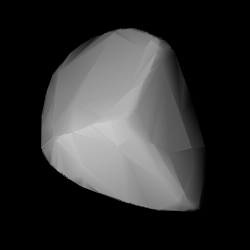
1555 Dejan, provisional designation 1941 SA, is an asteroid from the background population of the central regions of the asteroid belt, approximately 22 kilometers in diameter. It was discovered on 15 September 1941, by Belgian astronomer Fernand Rigaux at the Royal Observatory of Belgium in Uccle. The asteroid was named after Dejan Đurković, son of Serbian astronomer Petar Đurković.
4282 Endate, provisional designation 1987 UQ1, is an asteroid from the inner regions of the asteroid belt, approximately 10 kilometers in diameter. It was discovered on 28 October 1987, by Japanese astronomers Seiji Ueda and Hiroshi Kaneda at Kushiro Observatory (399) in Japan. It was named for amateur astronomer Kin Endate.
1541 Estonia, provisional designation 1939 CK, is an asteroid from the central regions of the asteroid belt, approximately 21 kilometers in diameter. It was discovered on 12 February 1939, by astronomer Yrjö Väisälä at the Iso-Heikkilä Observatory near Turku, Finland. The asteroid was named after the Baltic country of Estonia.
2126 Gerasimovich, provisional designation 1970 QZ, is a stony background asteroid from the inner regions of the asteroid belt, approximately 8 kilometers in diameter. It was discovered on 30 August 1970, by Soviet astronomer Tamara Smirnova at the Crimean Astrophysical Observatory in Nauchnyj, on the Crimean peninsula. The asteroid was named after Russian astronomer Boris Gerasimovich.
2173 Maresjev, provisional designation 1974 QG1, is a dark background asteroid from the outer regions of the asteroid belt, approximately 28 kilometers (17 miles) in diameter. It was discovered on 22 August 1974, by Soviet–Ukrainian astronomer Lyudmila Zhuravleva at the Crimean Astrophysical Observatory in Nauchnij, on the Crimean peninsula. It was named for Soviet war veteran Alexey Maresyev. The assumed C-type asteroid has a tentative rotation period of 11.6 hours.
1303 Luthera, provisional designation 1928 FP, is a dark asteroid and the parent body of the Luthera family, located in the outermost regions of the asteroid belt. It measures approximately 90 kilometers in diameter. The asteroid was discovered on 16 March 1928, by astronomer Friedrich Schwassmann at the Bergedorf Observatory in Hamburg, Germany, and later named after German astronomer Robert Luther.
2043 Ortutay, provisional designation 1936 TH, is a dark asteroid from the outer regions of the asteroid belt, approximately 45 kilometers in diameter. The asteroid was discovered by Hungarian astronomer György Kulin at the Konkoly Observatory, Budapest, on 12 November 1936. It was named after Hungarian ethnographer Gyula Ortutay.
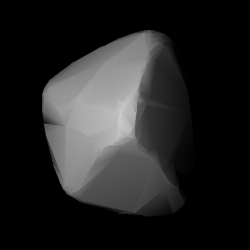
2120 Tyumenia is a dark background asteroid, approximately 45 kilometers in diameter, located in the outer regions of the asteroid belt. It was discovered on 9 September 1967, by Soviet astronomer Tamara Smirnova at the Crimean Astrophysical Observatory in Nauchnyj, on the Crimean peninsula. The asteroid was named for the now Russian district of Tyumen Oblast in Western Siberia.
(7563) 1988 BC, provisional designation 1988 BC, is a background asteroid from the central region of the asteroid belt, approximately 16 kilometers in diameter. It was discovered on 16 January 1988, by Japanese amateur astronomer Takuo Kojima at the YGCO Chiyoda Station in the Kantō region of Japan. The asteroid has a rotation period of 6.5 hours.
References
- 1 2 3 4 5 6 "3754 Kathleen (1931 FM)". Minor Planet Center. Retrieved 1 May 2018.
- 1 2 3 4 "JPL Small-Body Database Browser: 3754 Kathleen (1931 FM)" (2017-10-29 last obs.). Jet Propulsion Laboratory. Archived from the original on 15 September 2020. Retrieved 1 May 2018.
- 1 2 "Asteroid 3754 Kathleen – Proper Elements". AstDyS-2, Asteroids – Dynamic Site. Retrieved 29 October 2019.
- 1 2 3 4 5 6 7 8 "LCDB Data for (3754) Kathleen". Asteroid Lightcurve Database (LCDB). Retrieved 1 May 2018.
- 1 2 3 4 Tedesco, E. F.; Noah, P. V.; Noah, M.; Price, S. D. (October 2004). "IRAS Minor Planet Survey V6.0". NASA Planetary Data System. 12: IRAS-A-FPA-3-RDR-IMPS-V6.0. Bibcode:2004PDSS...12.....T . Retrieved 22 October 2019.
- 1 2 3 Masiero, Joseph R.; Grav, T.; Mainzer, A. K.; Nugent, C. R.; Bauer, J. M.; Stevenson, R.; et al. (August 2014). "Main-belt Asteroids with WISE/NEOWISE: Near-infrared Albedos". The Astrophysical Journal. 791 (2): 11. arXiv: 1406.6645 . Bibcode:2014ApJ...791..121M. doi:10.1088/0004-637X/791/2/121. S2CID 119293330.
- 1 2 3 4 Mainzer, A.; Grav, T.; Masiero, J.; Hand, E.; Bauer, J.; Tholen, D.; et al. (November 2011). "NEOWISE Studies of Spectrophotometrically Classified Asteroids: Preliminary Results". The Astrophysical Journal. 741 (2): 25. arXiv: 1109.6407 . Bibcode:2011ApJ...741...90M. doi:10.1088/0004-637X/741/2/90. S2CID 35447010.
- 1 2 3 4 Usui, Fumihiko; Kuroda, Daisuke; Müller, Thomas G.; Hasegawa, Sunao; Ishiguro, Masateru; Ootsubo, Takafumi; et al. (October 2011). "Asteroid Catalog Using Akari: AKARI/IRC Mid-Infrared Asteroid Survey". Publications of the Astronomical Society of Japan. 63 (5): 1117–1138. Bibcode:2011PASJ...63.1117U. doi: 10.1093/pasj/63.5.1117 . (online, AcuA catalog p. 153)
- 1 2 3 4 Nugent, C. R.; Mainzer, A.; Masiero, J.; Bauer, J.; Cutri, R. M.; Grav, T.; et al. (December 2015). "NEOWISE Reactivation Mission Year One: Preliminary Asteroid Diameters and Albedos". The Astrophysical Journal. 814 (2): 13. arXiv: 1509.02522 . Bibcode:2015ApJ...814..117N. doi:10.1088/0004-637X/814/2/117. S2CID 9341381.
- 1 2 3 4 Masiero, Joseph R.; Nugent, C.; Mainzer, A. K.; Wright, E. L.; Bauer, J. M.; Cutri, R. M.; et al. (October 2017). "NEOWISE Reactivation Mission Year Three: Asteroid Diameters and Albedos". The Astronomical Journal. 154 (4): 10. arXiv: 1708.09504 . Bibcode:2017AJ....154..168M. doi: 10.3847/1538-3881/aa89ec . S2CID 250780308.
- 1 2 3 Behrend, Raoul. "Asteroids and comets rotation curves – (3754) Kathleen". Geneva Observatory. Retrieved 1 May 2018.
- 1 2 3 Mansego, Enrique Arce; Rodriguez, Pedro Brines; de Haro, Juan Lozano; Chiner, Onofre Rodrigo; Silva, Alvaro Fornas; Porta, David Herrero; et al. (October 2016). "Eighteen Asteroids Lightcurves at Asteroides Observers (OBAS) – MPPD: 2016 March–May". The Minor Planet Bulletin. 43 (4): 332–336. Bibcode:2016MPBu...43..332M. ISSN 1052-8091 . Retrieved 1 May 2018.
- 1 2 Torno, Steven; Oliver, Robert Lemke; Ditteon, Richard (June 2008). "Asteroid Lightcurve Analysis at the Oakley Southern Sky Observatory – October 2007". The Minor Planet Bulletin. 35 (2): 54–55. Bibcode:2008MPBu...35...54T. ISSN 1052-8091 . Retrieved 1 May 2018.
- 1 2 "JPL Small-Body Database Browser: diameter > 50 (km) and a < 4.6 (au)". Jet Propulsion Laboratory. Retrieved 1 May 2018.
- ↑ "MPC/MPO/MPS Archive". Minor Planet Center. Retrieved 1 May 2018.